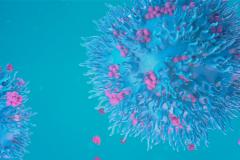Medulloblastoma (MB) is the most common pediatric brain tumour and usually affects children and infants under 10 years old. Current treatment for MB involves aggressive chemotherapy and radiation, which can lead to harmful long-term side effects, including cognitive impairment, endocrine disorders and an increased risk of secondary cancers later in life.
At BC Children’s Hospital, clinicians treat about four or five young children with cases of medulloblastoma each year. While chemotherapy and radiation are essential treatments for overcoming MB, finding new ways to treat the disease more effectively could lessen the later-in-life impacts of treatment and ensure more children survive.

A new study from BC Children’s Hospital and University of British Columbia (UBC) published in Cell Death & Disease - Nature, has found that certain immune signals may help MB resist chemotherapy. Blocking these signals could present a new way to improve treatment for children with this type of tumour and increase childhood survival.
The study was led by Dr. James Lim, investigator with the Michael Cuccione Childhood Cancer Research Program at BC Children's Hospital and associate professor with the UBC Department of Pediatrics. The first author on the paper, Lakshana Sreenivasan, is a graduate student on Dr. Lim’s research team.
The overall five-year survival rate for medulloblastoma is around 60 to 80 per cent; however, the disease has recently been classified into four distinct subtypes, and prognosis and treatment can vary depending on the classification. This study focused on the type with the lowest survival rate (below 60 per cent) known as Group 3.
“Although we’ve known about this disease for nearly a century, it’s only been in the last decade or so that we’ve really understood that there are four distinct subgroups of medulloblastoma,” said Sreenivasan. “Understanding the molecular differences between these varieties has enabled researchers to pursue more personalized treatments for these cancers based on their unique biological makeup.”
Immune response helps cancer cells enter ‘survival mode’
The researchers grew MB cells in the lab and exposed them to increasing levels of chemotherapy to see how they responded. They discovered that interleukin-6 (IL-6), a protein that helps regulate immune responses, and the signaling molecule it activates called STAT3, were crucial to the cancer cells’ ability to survive chemotherapy.
“The key to overcoming this horrific disease is understanding why some cases of medulloblastoma relapse and become drug resistant,” said Dr. Lim. “Our research team set out to uncover the molecular basis for this resistance and what biological factors may help these cancer cells escape chemotherapy.”
The research team began by using small amounts of chemotherapy on MB cells in the laboratory to see how they responded. They found that expression of IL-6 enabled these cancer cells to enter a ‘survival mode,’ allowing them to resist the damaging effects of chemotherapy. They also found that once the cancer cells began making IL-6, this signaling encouraged the same cells to make even more IL-6, creating a positive feedback loop.
“The most interesting result was when we gave MB cancer cells IL-6 prior to chemotherapy,” said Dr. Lim. “In just two weeks, MB cells given IL-6 had become even more drug resistant than those that had been dosed with increasing levels of chemo. This surprising result emphasized the importance of this immune signal in enhancing drug resistance in MB tumours.”
This research suggests that blocking these immune signals may increase the effectiveness of chemotherapy by eliminating one of the ways MB resists treatment. These findings could pave the way to better and more effective treatments for MB. If blocking immune signaling enables current chemotherapy treatment to be more effective, then it could reduce the chance of the cancer recurring.
“Because MB particularly affects young children, treatment such as radiation can have a severely detrimental effect on their cognitive abilities, affecting their life-long development,” said Lakshana Sreenivasan. “Finding new ways to directly target the tumour, or remove its defenses to current treatment, can potentially save more kids’ lives and improve their health and quality of life for the rest of their lifespan.”
COVID-19 creates challenges for research team
While the research team was working on this study, a new and unexpected challenge emerged. The COVID-19 pandemic forced the research labs to shut down, preventing the team from continuing their important work. The team submitted the paper for peer review and were asked to run some more experiments; however, the labs had closed due to public health orders.
"We submitted the paper at the end of February, but the reviewers got back to us at the end of April, when the lab was already closed due to the pandemic; we weren’t able to get back into the lab until June,” recalled Sreenivasan. “Once we were able to return to the lab, we weren’t able to operate with a full team, and the experiments we needed to perform were quite long and complicated. Logistics were also a challenge – getting reagents and other supplies on time was very difficult."
Following strict COVID safety protocols, the lab was able to open again safely in June but without full-time staff. Because they had to conduct research with limited team members, they took turns working long shifts to complete the experiments on time. By the end of August, things were running more smoothly, and they were able to complete their work.
Next steps
This research has shed light on how the tumour microenvironment and molecular signals impact the susceptibility of these cancer cells to standard therapy. The next step is to better understand whether non-tumour cells may be providing this ‘initial’ signal to cancer cells, mistakenly enabling their survival.
“This paper shows that if we give the cancer cells a little nudge, they are able to produce their own IL-6 to help escape the most damaging effects of treatment,” said Dr. Lim. “But in a real tumour, cancer cells aren’t lined up by themselves in a dish. There are many other types of cells nearby supplying their own molecular signals, so we need to investigate how those signals also impact drug resistance.”
All the research was done in the labs at BC Children’s Hospital Research Institute. Financial support was also received from the Michael Cuccione Foundation and the Murray Family.




